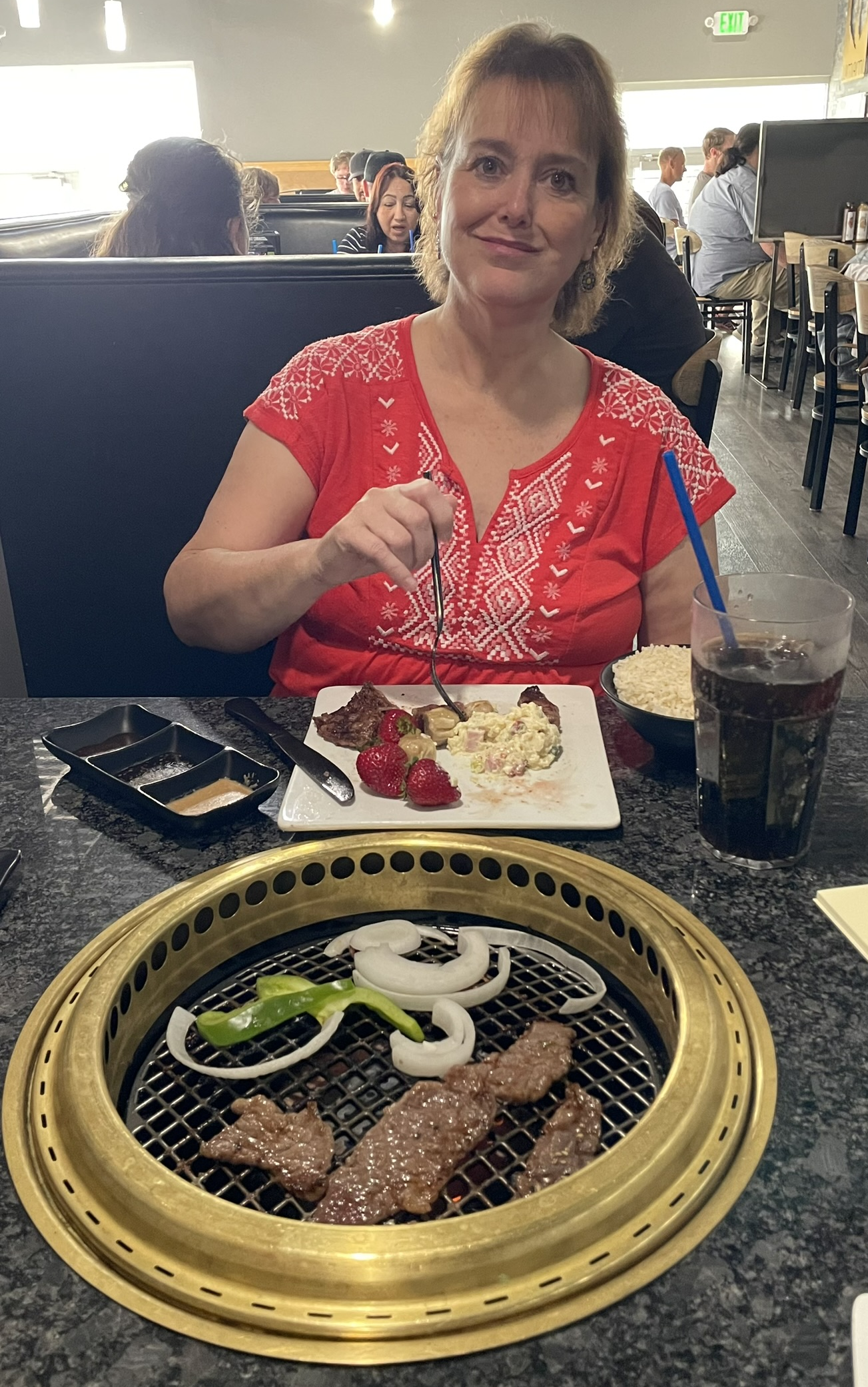
Umami Japanese Barbecue
He said:
We drove to Vineyard, in Utah County, for lunch today. Vineyard isn’t a big place, perhaps not well known. However, it’s one of the fastest-growing cities in Utah, even one of the fastest-growing in the country. When I grew up in Orem, I knew Vineyard only as some vaguely defined area down the hill by the lake. As far as I knew, it seemed entirely covered by the Geneva steel mill, which sat between the freeway and the lake, spanning about two miles from end to end. After the mill shut down and the property was rehabilitated and redeveloped, Vineyard grew its population from 139 (2010 census) to over 12,000 (2020 census).
The Umami Japanese Barbecue restaurant sits within The Yard, a Vineyard shopping district. Next door to Topgolf, The Yard might be better known for its anchor property, the Larry H. Miller Megaplex Theater. At the entrance to The Yard, we found an enormous casting ladle, or cauldron, adorning the center of the roundabout. I appreciated this tribute to the region’s history, but I didn’t realize how unfathomably large these ladles were until Kathy stood next to it for a photo.

Usually, we go out to eat to avoid cooking for ourselves. However, at Umami, cooking your own meal is part of the fun, as Umami Japanese Barbecue presents a Yakiniku dining tradition. Though “Yakiniku” literally means “grilled meat” in Japanese, it more broadly represents a dining style derived from the Korean barbecues that began to spread through Japan after World War 2. Yakiniku restaurants serve prepared raw ingredients, which diners cook on grills built into their tables.
At Umami, the food was served in an all-you-can-eat buffet style. The buffet included four stations. The first featured ready-to-eat fruits, vegetables, salads, and a shrimp cocktail. I especially enjoyed the kimchee1. The second station included pre-cooked options, including yakisoba noodles, potstickers, and a Japanese curry.
The last two stations featured an impressive selection of raw meats, often marinated and/or seasoned. Some were cut thinly; others into bite-sized pieces. There were so many varieties that I couldn’t try most of them. Even choosing which ones I would prefer proved daunting. None that I tried disappointed me.
I didn’t find my go-to Korean favorite, spicy pork bulgogi, but I did find a spicy Korean pork belly. I also enjoyed some kalbi-style short ribs. I tried a cut of lamb, some brisket, two varieties of New York strip steak, and some ribeye steak. (That sounds like a lot, and it was, but I only took a few small pieces of each, for both me and Kathy). The steaks were cut into bite-sized pieces, from which I selected some with obvious marbling for additional flavor.
We took our selections to our table, which included a smokeless grill in its center. Our cloth napkins wrapped packets of chopsticks, cooking tongs, and tri-sectioned trays to hold our dipping sauces, which we dispensed from bottles at the table. The waiter brought us our choice of white or brown rice.
The three sauces included Roasted Sesame, Garlic Shoyu, and Hokkaido Miso Apple. I was surprised when Kathy said she didn’t care for the Hokkaido Miso Apple sauce, as it was my favorite. She preferred the Roasted Sesame sauce, which I liked, though not as much as the other two. I guess that’s why they offer three choices.

The Yakiniku concept proved to be a lot of fun, with the experience made better by the quality and abundant selection of meats. There were a few vegetable options, which Kathy appreciated, but I think we would have both liked to see a few more.
She said:
At Umami, patrons can expect friendly service and a sophisticated, relaxed vibe.
We chose to be seated on the upper tier of the split-level dining room, where we thought we’d enjoy a bit more privacy and coziness—and we were right. Once seated, I took in our surroundings. One wall was constructed of medium-hued gray stacked stone. Black floating shelves on that same wall held realistic-looking artificial bonsai trees. The floors were gray wood-grained vinyl planks. The granite-topped tables were swirled in a black and gray pattern. The chairs were made from wooden backs and seats, with black metal frames. The booth benches had dove-gray vinyl (or leather) backs. Everything was rather understated and chic.
Unlike other cook-it-yourself Asian BBQ restaurants, Umami held fresh ingredients at buffet stations instead of waitstaff bringing raw foods to the table. I was impressed with the selection of meats and seafood—although there was no way that I’d try the cow tongue (keep moving down the line, Brian!) But what really pleased me was the array of fresh fruits and vegetables: strawberries, pineapple, mushrooms, onions, green bell peppers, Japanese pumpkin, watermelon, orange slices, edamame, and other items. The reason that this excited me is because similar establishments are often heavy with meats as opposed to fresh produce. Their potato salad was especially delicious, and I really enjoyed the brown rice. I’m glad we were given a choice between that and white rice.
Of all the Asian BBQ places we’ve visited, Umami is hands-down my favorite.
There would just be one change that I’d suggest: replace the flat white plates with concave or edged ones because my strawberries and other selections wanted to roll right off the surface!

Conclusion:
Don't let somebody else cook for you! Go to Umami for a good time while you cook your all-you-can-eat meal just to your liking. Lunch pricing is available Monday through Friday. Dinner prices are in effect evenings and all day on Saturday.
-
Umami spells it “kimchee” instead of “kimchi,” even though I’ve heard that the “kimchee” spelling is usually favored by Korea rather than Japan. See, for example: https://kimcheegirl.com/blogs/kimchee-girl-news/kimchee-or-tasteless-misspelling↩